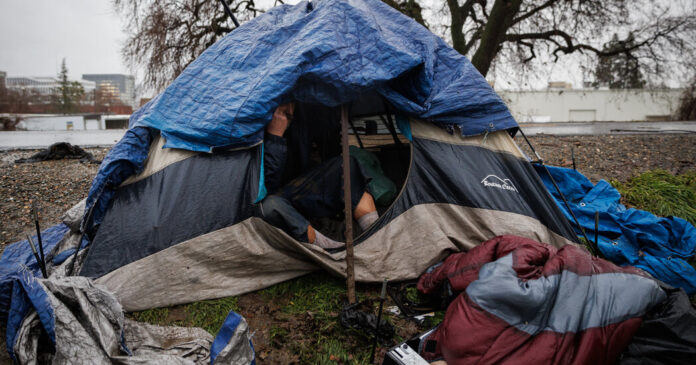California has about 12 percent of the nation’s population but more than a quarter of America’s homeless people — 181,000-plus at last count.
There are many reasons for this outsize problem, including generations-old state laws that deinstitutionalized mentally ill people as well as high housing costs that have since priced tens of thousands out of shelter. But since the pandemic turned fentanyl abuse and tent camps into inescapable symptoms of a public health crisis, state policymakers have been under intense pressure to rethink California’s approach to behavioral health.
Last week, Californians voted on a key piece of that rethinking — a deeper focus on treatment and housing for homeless people with severe mental illnesses and substance use disorders. The ballot measure, called Proposition 1, was the product of months of work by Gov. Gavin Newsom to gather statewide support.
Polls suggested that Proposition 1 would be a slam-dunk. But so far, it is barely passing. Entering the week, the measure is hanging on with 50.5 percent of the vote and an estimated 2.5 million ballots left to count. So what happened?
Here’s what to know about Proposition 1 in California.
What is Proposition 1?
Placed on the ballot last year by state lawmakers and Mr. Newsom, Proposition 1 asks voters to dramatically expand treatment centers and supportive housing for people struggling with mental illness and addiction. The measure would authorize $6.38 billion in bonds to pay for facilities and housing and would amend the Mental Health Services Act, a 20-year-old state tax on millionaires, to shift about $140 million annually from counties to the state. The measure also would set aside about $1 billion to house homeless, mentally ill or addicted veterans.
What are the arguments for and against Proposition 1?
Proponents of Proposition 1 say it is key to restructuring California’s behavioral health system. One reason so many addicts and mentally ill people are on the street, they say, is that the state has an acute shortage of adult treatment beds. Proposition 1 would help house more than 11,000 sick people and help underwrite CARE Court, a new state program that would require people to enter treatment for certain psychotic disorders. The measure would explicitly extend a huge source of treatment dollars to homeless substance abusers. And, proponents say, Proposition 1 would lessen taxpayer spending on a population that is now largely being treated in jails.
Some civil libertarians fear Proposition 1heralds a return to the days when involuntary treatment was the norm for mentally ill people. But most opponents cite fiscal concerns. Critics say that California has already thrown tens of billions of dollars at homelessness only to see it worsen. Critics note that although Proposition 1 would not add new taxes, it would limit the amount the state could borrow for other issues and commit taxpayers to new debt amid high interest rates. Also, counties rely on the Mental Health Services Act to pay for programs that are not covered by California’s version of Medicaid or by other less flexible funding sources, and Proposition 1 would shift some of that money to the state.
Why is the vote so close?
Newsom administration officials say that their internal polling had always forecast a close vote. Turnout in California is usually lower in primaries than in general elections and is less heavily dominated by like-minded Democrats.
The bond measure is long and confusing and comes as the state is grappling with a budget shortfall. Mental health policy is a fraught issue in California, and proposed shifts tend to draw passionate pushback from civil liberties groups. And many voters are frustrated and fatigued by the sheer scale of California homelessness — and skeptical that any ballot measure could solve the problem.
But turnout was low, even for a primary. Without a close race for the presidential nomination in either party, only about a quarter of the state’s 22 million or so registered voters cast a ballot, according to the most recent statistics — the lowest participation rate in a presidential primary in at least 20 years.
The surprising proportion of Republicans also has affected the results. They make up less than a quarter of registered voters but were on track as of this weekend to make up nearly 30 percent of the turnout. Some Democratic analysts have pointed to the state’s Senate race, in which the front-runner, Adam Schiff, ran tens of millions of dollars on ads that elevated the profile of his preferred opponent, Steve Garvey, a political novice and Republican.
When will the final results be known?
Because California relies heavily on mail-in ballots, the vote count typically consumes weeks, but most observers expect a clearer picture within days.
Each of California’s more than 22 million registered voters was sent a ballot, but only about a third of them voted. According to the most recent state figures, about 2 million ballots have yet to be processed. Elections officials have until April 5.
But the sources of those remaining ballots hint at Proposition 1’s prospects. Campaign officials said late last week that though some large conservative precincts still needed to be counted, many more outstanding ballots were in major urban areas. Those parts of the state — Los Angeles and Alameda Counties, for instance — are heavily Democratic and more likely to vote “yes.”



